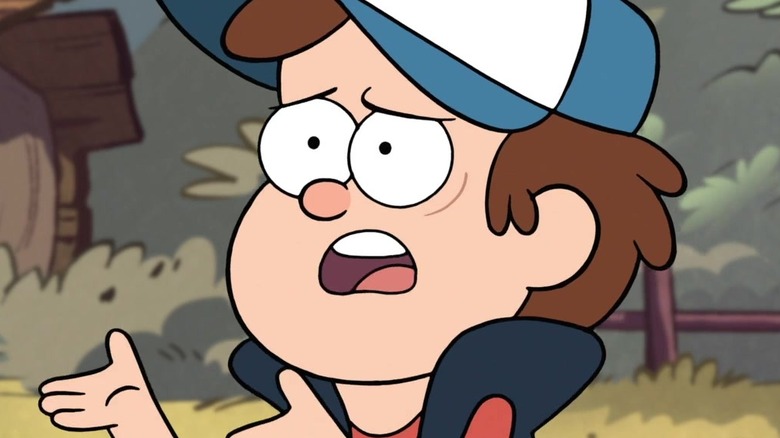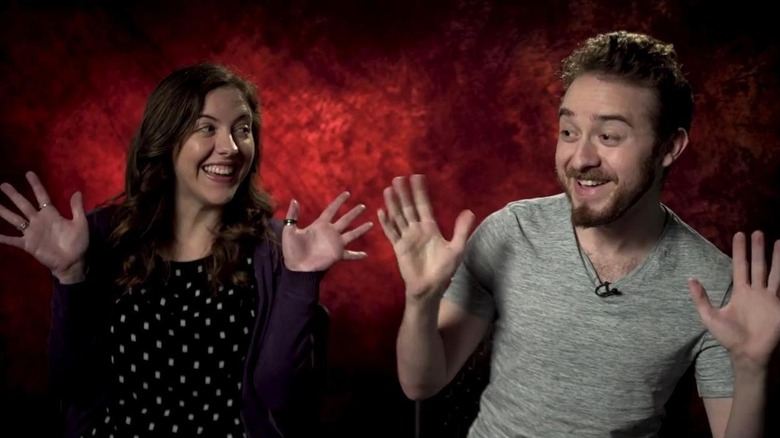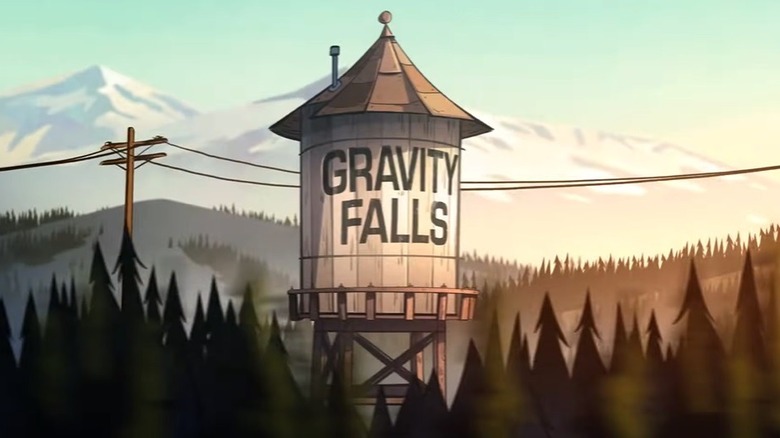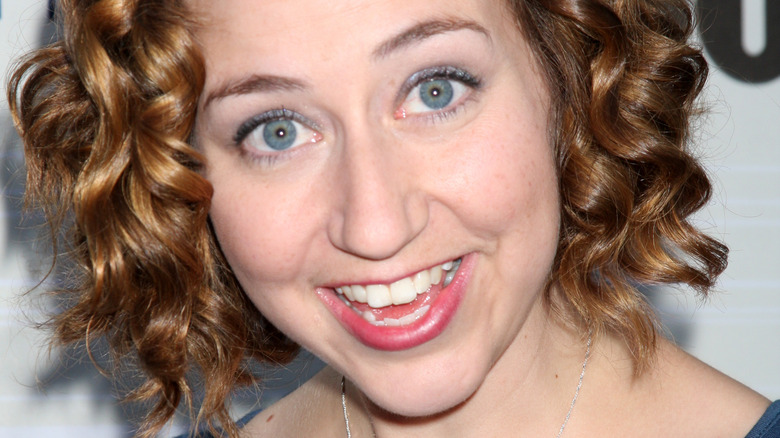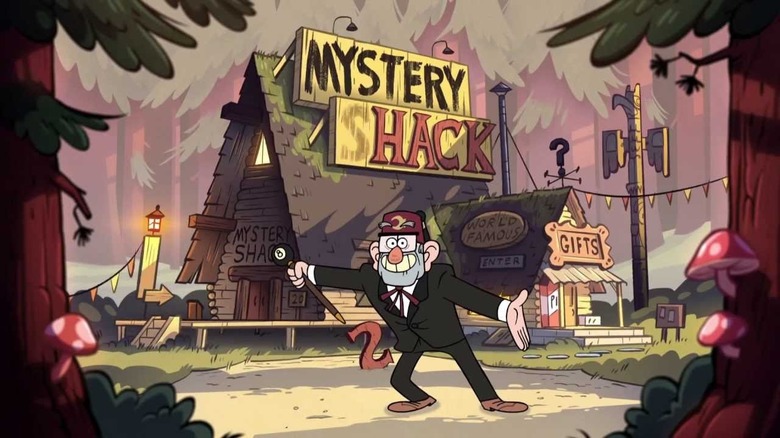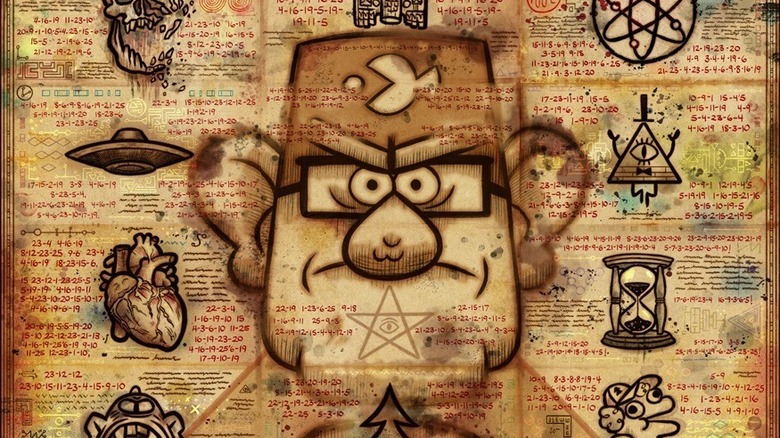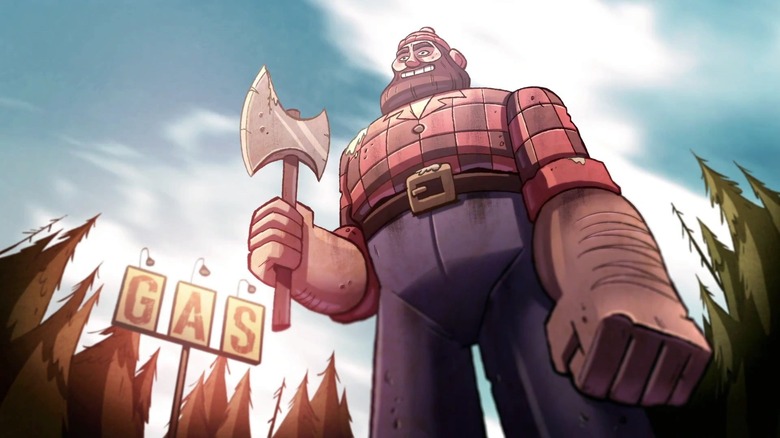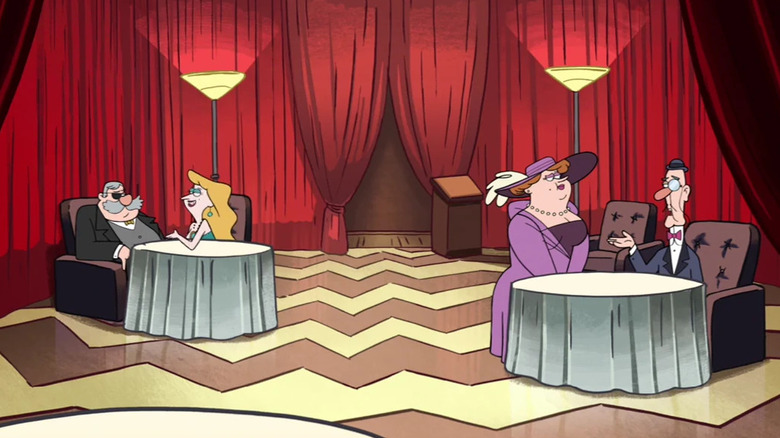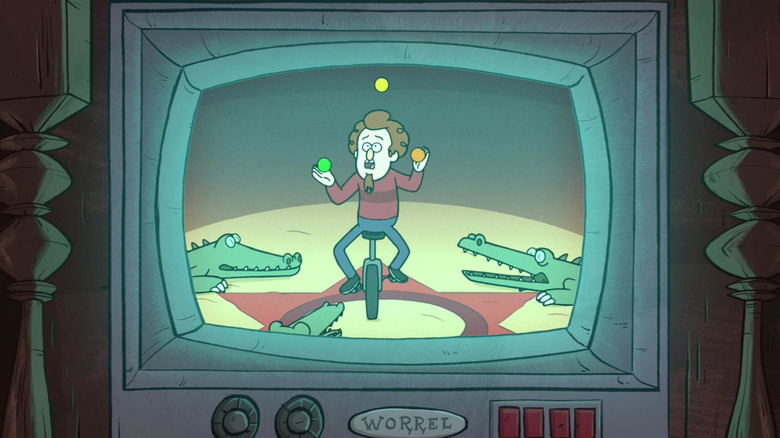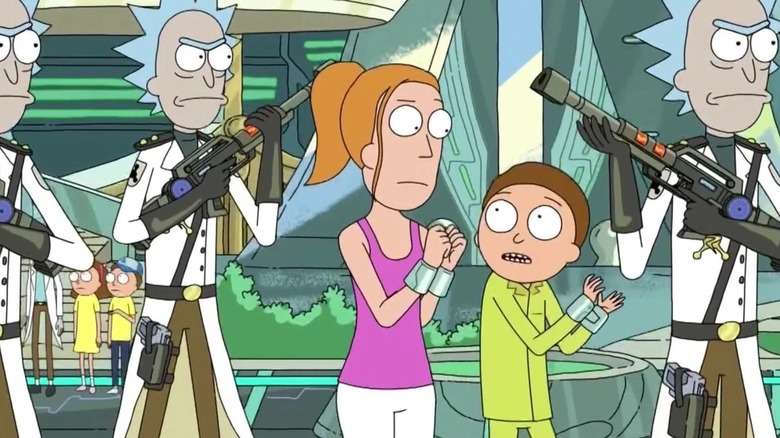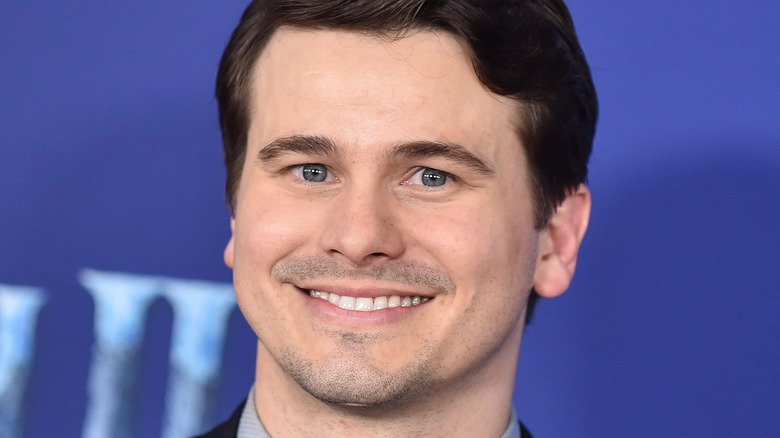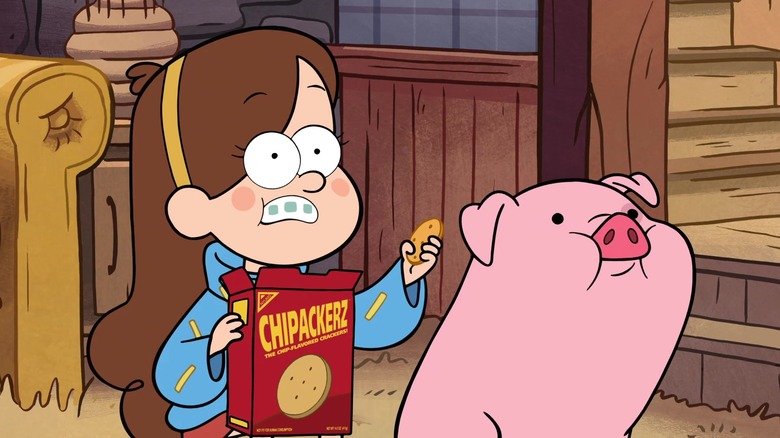The Untold Truth Of Gravity Falls
Even though it's technically a show for kids, there's something for everyone to enjoy in "Gravity Falls." Debuting in 2012, the hit Disney series ran for a total of 40 episodes. It's a kooky family affair, with twins Dipper and Mabel Pines being sent off to Grunkle Stan's Mystery Shack for the summer. Along with a host of hilarious characters, the duo face off against the supernatural, mythical, and downright scary.
It's safe to say the show has a cult following, despite its short run of only two seasons. Fans were devastated when it came to an end, but creator Alex Hirsch always intended to wrap it up this way. "This is 100% my choice, and it's something I decided on a very long time ago," he said. "I always designed 'Gravity Falls' to be a finite series about one epic summer — a series with a beginning, middle, and end."
The final episode aired in 2016, but "Gravity Falls" has stood the test of time and continues to suck in new viewers to this day. Why? Because fans are encouraged to expect the unexpected. Though the episodes are only around 25 minutes long, they are packed with hidden clues, codes, and ciphers that keep people glued to the screen. No detail is too small to be unimportant.
Even if you've seen the show several times over, chances are there are things you don't know about it. Read on for the untold truth of "Gravity Falls."
Mabel is based on Alex Hirsch's twin sister
They say great writing comes from sticking to what you know, and "Gravity Falls" creator Alex Hirsch did exactly that. Mabel and Dipper Pines aren't the only twin siblings linked to the show, with Hirsch's inspiration for the two loosely based on him and his twin sister Ariel. While the two never had to spend time at a rundown mystery shack, they did visit numerous national parks as kids. The Pines kids even have similar personalities to the real-life duo, with Mabel's obsession with boy bands and colorful language rooted in Ariel's tween years.
In an interview with Comics Alliance, Hirsch revealed that his childhood was a huge influence on him when he started to develop "Gravity Falls." He said: "When I came up with the show and pitched it to Disney, the thing that I was most excited about — sort of tied in excitement with being able to tell stories with magic, monsters, and mayhem — was to make fun of my sister for twenty stories a year. I was really excited to mine my comedic relationship with my sister, to deliver her weirdness to America, and that's probably the core of the series."
Mabel Pines is routinely ranked as the show's best character, with Dipper a close second. "She's a far more dynamic character than Dipper, making her a perfect lead for any storyline, but she never feels misplaced or out of her element during the mythology-heavy episodes," Paste magazine said.
Gravity Falls is inspired by a real place in Oregon
According to Google Maps, the fictional town of Gravity Falls can actually be visited — kind of. When you search for "Gravity Falls, Oregon," the site pinpoints the Oregon Vortex, a real-life mystery shack said to be a hotspot for paranormal activity. Opening to the public in 1930, it's been a must-see for ghost hunters for decades. "Local legend in the area states that prior to any sort of construction in the area, Native Americans referred to the land as 'forbidden,' and travelers that were passing through would experience strange behavior from their horses as they refused to enter the area," the website U.S. Ghost Adventures states.
The town that appears in the show is partially based on Boring, Oregon — even though "Gravity Falls" is anything but boring. Speaking to Oregon Live, Alex Hirsch revealed that he became fascinated by the town after spending the summer of 2006 in Oregon for work. "We passed a sign for Boring, Oregon," he recalled. "We never went there, but I was positively enchanted with the idea that there was a town called Boring. Gravity Falls is partially from what I imagine Boring might be like. Or maybe the opposite of Boring, Oregon, would be Gravity Falls."
The show might not have happened without Kristen Schaal
Fans of "Gravity Falls" became used to hearing celebrity voices in cameo roles, but there's one voice that might feel more familiar than the rest. With her distinctive, high-pitched sound, Kristen Schaal is the voice behind Mabel Pines. According to Hirsch, getting Schaal on board was absolutely vital — in fact, the show might not have moved forward at all if she had turned the role down.
"In terms of Mabel, I knew from the get-go that it's got to be Kristen Schaal or there's no show," Hirsch told AV Club. "I would've just stopped working. If we hadn't gotten her, I would have probably quit." While Mabel was based on his twin sister, Hirsch has revealed that the character quickly became a mix of his sibling and Schaal. "We Kristen Schaal-ed it up, because when you have a great actress like that you have to."
Schaal has said on numerous occasions that she connected with the character instantly, which made playing Mabel a breeze. "I see a lot of myself in Mabel," she told Geek Dad. "I think that out of all the characters that I've played, Mabel is probably closest to who I really am. It's very easy to play her. I was a goofy little girl with braces and long brown hair, and I know I just would've had a ball at the Mystery Shack in Gravity Falls."
The credits contain hidden messages
All the best animated shows have catchy theme tunes, and "Gravity Falls" has one of the most whistle-worthy intros of recent memory. The opening credits take viewers on a quick tour of Gravity Falls, showcasing some of the weird and wonderful things that Dipper and Mabel see during their memorable summer. But, like every episode of the show, there are more layers to the intro than you may have realized. Towards the end of the sequence, there's a faint whisper that appears to be another language. In actuality, it's a message that's only revealed when played backwards.
"For the first few shows this message, when reversed, said 'Three letters back' — indicating the cryptographic device known as the Caesar cipher, wherein an alphabetic message can be decoded by shifting each letter by three characters," Wired discovered back in 2012. "In episode seven, this was replaced by the message 'Switch A and Z' — the Atbash or reverse alphabet cipher." Using these formulas, viewers can decipher codes in the end credits sequence, which are unique to their particular episode. For example, the end credits of the episode "The Time Traveler's Pig" contains the message "Not H.G. Wells approved."
Interestingly, the "Gravity Falls" opening credits sequence that we all know and love was originally very different. Alex Hirsch initially wanted the intro to be a homage to old cartoons, but the higher-ups at Disney told him to make it "more modern." He shared a link to the original intro on Twitter in 2017.
Cracking the show's many codes
On top of containing a message that can be deciphered using the whispered hint in the opening sequence, the images that flash up on screen right at the end of the closing credits are actually part of a larger puzzle. These images are only shown for a split second, but if you pause at the right moment, you'll notice how incredibly detailed they are. The numbers you see here are codes to be cracked, and the images are jigsaw pieces that fit together to create a giant image of Stan and his brother Ford.
A code that fans are still puzzling over to this day is the one left by the show's memorable villain, Bill Cipher. If you play his final words in reverse, you'll hear: "A X O L O T L! My time has come to burn! I invoke the ancient power that I may return." The mystery deepened when fans discovered a secret A X O L O T L page in the Choose Your Own Adventure book. When The Mary Sue asked Alex Hirsch about the meaning of Bill's message, he said: "I like stories that complete their emotional arcs, but still leave some lingering threads to chew on. It gives the fans something to theorize on, and it gives me a window back into that world if I ever choose to return to it."
Real-life mystery locations are used
Between the first and second season of "Gravity Falls," Alex Hirsch took a road trip from California to Oregon and stopped at every unusual tourist attraction along the way. Look closely enough and you'll see their influences in the show. It was on this road trip that Hirsch became acquainted with the aforementioned Oregon Vortex, which partly inspired the Mystery Shack. "[It's] a weird slanted shack where a ball will roll uphill and people look like they are growing or shrinking based on where they stand in the shack," Hirsch told Media Mikes. "Depending who the tour guide is they will tell you it is an unbelievable dimensional spot in the universe where the laws of gravity don't work... or they say 'Yeah, it's an optical illusion — buy a keychain!'"
Hirsch also visited a place called Confusion Hill, which became another source of inspiration for the Mystery Shack. "I would say that the Oregon Vortex is more for people that are hardcore into this stuff and want to believe," he said. "Confusion Hill is more for people with a sense of humor and more of a Grunkle Stan-type scenario." Perhaps the biggest influence on Hirsch was Oregon's Trees of Mystery, a nature trail located at the center of a national park full of enormous Redwood trees — and fronted by a gigantic lumberjack statue. This real life statue is almost identical to the one that appears in the opening credits of "Gravity Falls," and the ghost of a lumberjack named Archibald Corduroy serves as the antagonist of the episode "Northwest Mansion Mystery."
There are multiple connections to Twin Peaks
A show known for its stunning visuals, David Lynch's influential series "Twin Peaks" is the ultimate cult hit set in a spooky woodland. First airing in 1990, the fictional town is home to plenty of supernatural drama and eccentric characters. The quirky setting of "Gravity Falls" owes a lot to "Twin Peaks" — both are stacked with Redwoods and mystery lies around every corner. There is even a direct visual comparison between the two. The club that is featured in "Gravity Falls" is an exact match of the Red Room in "Twin Peaks," right down to the two lamps placed by the curtains.
Alongside these blink-and-you'll-miss-them treats, fans have also drawn their own character comparisons. According to one Reddit thread, Dipper's curious nature is reminiscent of Agent Dale Cooper. Lil' Gideon, one of the main villains in "Gravity Falls," appears to parallel Windom Earle in "Twin Peaks." Even the Mystery Shack could be seen as similar to the Great Northern Hotel. Weird coincidence? Absolutely not. Alex Hirsch has been open about "Twin Peaks" being a huge influence on his show, and has even revealed that he wanted David Lynch to voice Bill Cipher. "When he turned us down, I just did a bad impression of him," he told his Twitter followers.
An animated Alex Hirsch has popped up in the show
Whatever happens in "Gravity Falls," it can all be traced back to creator Alex Hirsch. From childhood influences to Oregon road trips with his crew, the show's success is a testament to his attention to detail. Hirsch provides the voices for major characters like Grunkle Stan, the maniacal villain Bill Cipher, and Stan's loveable employee Soos, but there's one detail that fans might have missed — there's an animated version of Alex Hirsch hidden in each episode.
As is so often the case, the clues are held in the credits. Towards the end of the opening title sequence, we see a group of polaroid photos depicting some of the mysterious characters Dipper and Mabel encounter during their weird and wonderful summer at Grunkle Stan's place. If you pause each episode at this point, you'll see that one of the photos is of a regular guy with a goatee — Alex Hirsch's goatee. The creator has also appeared in the show itself. In one scene shown on a TV set, he rides a unicycle while juggling in front of some alligators.
The show's relationship with Rick & Morty explained
Fans have often wondered if "Gravity Falls" and "Rick & Morty" are connected, and the mass of Easter eggs hidden within different episodes of the latter show proves the theory to be true. One of the biggest merging of worlds is thanks to the journals, the infamous guides to the mysteries of Gravity Falls religiously used by Dipper. Journal 3 is featured in the Season 3 premiere of "Rick & Morty," where Rick must escape from the Galactic Federation's high-security prison. When walking through the Federation with Rick, Morty is holding the journal. In the same episode, versions of Morty dressed like Dipper and Mabel can be glimpsed.
Bill Cipher shows up briefly in the episodes "Rixty Minutes" and "Big Trouble in Little Sanchez" (as a taxi sign and on a computer monitor, respectively), and a number of objects from "Gravity Falls" can be seen flying out of one of Rick's portals in "Close Rick-counters of the Rick Kind." In this same episode, there's an emphasis on a parallel universe with talking chairs, similar to one seen in "Gravity Falls" — in the episode "Weirdmageddon Part 1," Soos' grandmother Abuelita is transformed into a talking recliner.
Speaking to The Mary Sue, Alex Hirsch revealed that he and "Rick & Morty" co-creator Justin Roiland have been good friends for a long time. "There's been a lot of hay made out of the little winks about 'Gravity Falls' in 'Rick & Morty,' and vice versa," he said. "The truth is just that we've been friends since before we had TV shows, and enjoy messing with people."
Jason Ritter was almost replaced as the voice of Dipper
Amazingly, fan-favorite Jason Ritter was almost replaced as the voice of Dipper. With his curious nature and commitment to getting a job done, Dipper's sense of self is synonymous with Ritter's voice acting. Could we imagine someone else in the role? Not really. Yet, by the time Disney had picked up "Gravity Falls," Ritter had signed onto another show. "I auditioned for the part [of Dipper], I ended up getting it and we did a pilot," he told The TV Sisters. "And then by the time Disney picked it up, I was working on another show and the show wouldn't let me do 'Gravity Falls.' And I was really heartbroken! I did that show for an entire year and any time I thought of 'Gravity Falls' I got really sad because I knew they were re-casting me."
In the end, fate brought Ritter back to "Gravity Falls." The show that was barring him from working on the Disney cartoon got canceled, meaning he was free to do as he pleased. Fortunately for him, they still hadn't recast the role of Dipper. "I was able to go back and do it," the actor explained. "So it all worked out perfectly and I feel very lucky." Alex Hirsch has since revealed that Dipper was particularly hard to cast because his personality sits somewhere between man and child. "Whenever we tried to cast kid actors he didn't seem to have the sharpness that we wanted," Hirsch told AV Club. "But when we found Jason, he and Kristen [Schaal] had such a contrast to each other."
The celebrity cameos you might have missed
With so much going on in each episode, it's easy to miss the many celebrity cameos in "Gravity Falls." Neil deGrasse Tyson plays Mabel's pet pig Waddles after he gains the ability to talk. Waddles turns into a super genius and builds a time machine, so it's not hard to see why Tyson was perfectly suited to the role. "I'm a fan of helping anything get smarter," the author and astrophysicist told Time magazine. "Even if it's a pig."
Rapper Coolio and talk show legend Larry King voice waxwork versions of themselves on the show. "Directing Coolio and Larry King back-to-back was probably one of the more surreal experiences of my professional career," Alex Hirsch told AV Club. NSYNC's Lance Bass portrays a fictional boy band hunk, and Weird Al Yankovich voices Probabilitor the Annoying in the episode "Dungeons, Dungeons, and more Dungeons." And, to top it off, the "Twin Peaks" references truly live on through the local bus driver in the final episode, voiced by Kyle MacLachlan.
